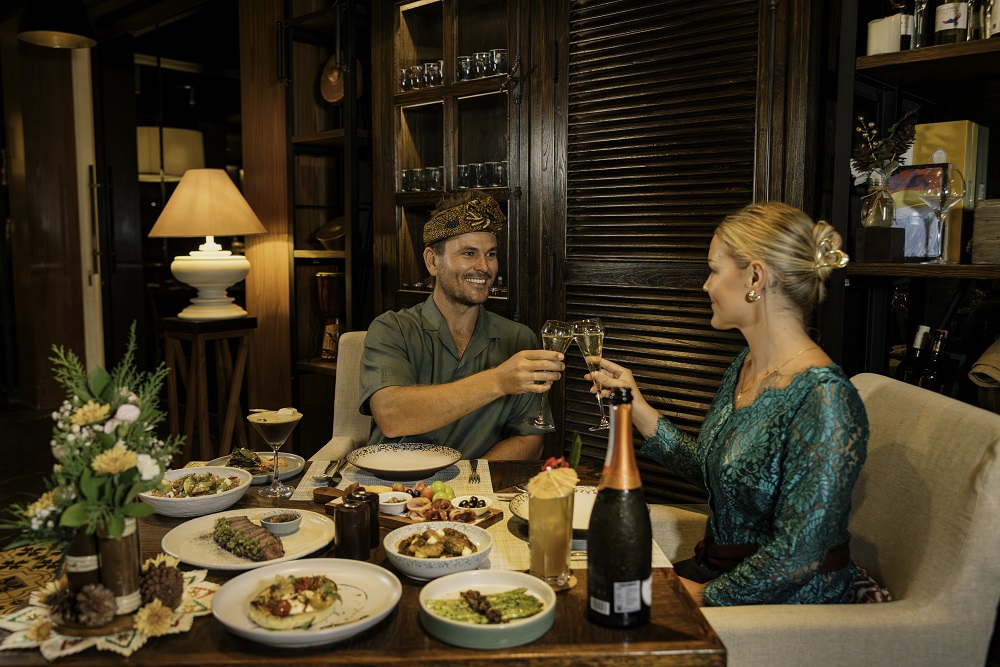Journalist Eric Buvelot and socio-ethnologist Jean Couteau have recorded 20 hours of discussion about changes that have happened in Bali since the 70’s. The conversation was structured and segmented according to many different aspects of Balinese life, mostly from a socio-historical perspective, to trace all the overturning in Balinese mores since 50 years, when modernity started to shape new behaviours.
At the core of these changes, the birth of individuality in a communal society and the revolution it implies. The resulting changes have been more significant in 50 years than the ones happening during the previous millennium. At the end of this project, a 16 chapter discussion book was published in 2021 in France by Editions GOPE (Bali, 50 ans de changements – Entretiens avec Jean Couteau) with the purpose of measuring to which extent Bali has morphed in so little time, a work never done before, encompassing all Balinese social matters. The English version (Bali, 50 Years of Changes – A Conversation with Jean Couteau) has followed in May 2022 with a translation made by renowned Bali-based American writer Diana Darling and published by Interactive Publications Pty Ltd (Australia).
This month, we take a look with them at how the Balinese cult of ancestors has evolved into more normative Hinduism.

Eric Buvelot. — What is the Balinese religion today?
Jean Couteau. — These days, if you ask Balinese what their religion is, most of them will say they are Hindus. Some go so far as to follow Indian rites, but in reality, if we go to the foundations of their beliefs, the village dimension, we find that they are in fact not very Hindu. In the villages, people primarily address their ancestors. When there are temple festivals, the attending gods are ancestral deities, accompanied by all kinds of ancangan (companion of the gods) not the Hindu gods. These may reside on the mountains, as the old treatises say, but they do not come down “visiting” like the temple gods… They therefore command things from the heights without really interfering in the ritual. This says a lot about syncretism: the Balinese religion is a cult of ancestors embellished with a cult of nature on which is superimposed an Indianised cosmological reading — and which the Balinese are in the process of ‘re-Indianising’ in modernity.
EB — Justified, nonetheless, by history …
JC — Yes. This phenomenon of superposition has indeed existed for more than a thousand years, but in a different way according to the social spaces. Indian traditions, let’s say the Hindu gods, penetrated from the “top”, via palaces and networks of Brahmans and associated meditators; they then spread through the wayang shadow-puppet theatrein particular. This “Hinduism” arrived not from India, but from Java in different waves during the twists and turns of history, the strongest of these being the Javanese invasion by the Majapahit empire (in the 14th century).
The cremation rite of ngaben, for example, is more Balinese than Hindu. Its objective is certainly to separate the bodily elements from the spiritual elements, in the Hindu manner — except that these bodily elements will end up in the sea, passing first, most often, by the river, while the soul will ultimately be taken back, in rite after rite, to the mountain of its origins where it will “become water” (dadi yeh), as people say, awaiting its return as “drops” (titisan), the reincarnated ancestor. It is all very Balinese.
EB — The notion of reincarnation is still of Indian origin…
JC — Yes, but here it is Balinised, translated by the symbol of the droplet, or titisan. We can see the amalgamation of the cult of nature, here water, and the cult of ancestors, because ancestors have become water.
Let’s say that first is the desire for a child, which opens up the possibility for ancestors to reincarnate. Couples still often request it in a temple, usually a family or clan temple. This is nakti. In the domestic temple, one doesn’t address the great Hindu gods for this purpose, but the ancestors, because it is they who will incarnate. This reincarnation sets in motion both cosmic material forces and the soul of a deified ancestor (betara) in the process of reincarnation, who descends by the paths of love.
EB — What then does ancestor worship consist of?
JC — In the Balinese tradition, life is a passage waiting for a return. The ancestral soul descends from the mountain heights, is embodied in one of its descendants, and must maintain an existence balanced by rites addressed to the gods, ancestors, and lower forces. Any imbalance and, in particular, any neglect of one’s obligations towards the ancestors, results in misfortune. Complex funerary rites — cremation, dispersing the ashes into the sea, etc. — allow the soul of the deceased to reach the “old country” above the mountains, awaiting a new incarnation.
EB — So there is no question of reincarnation according to one’s karma, nor of gods from the Hindu tradition.
JC — Very little. During trance, it is never the Indian Hindu gods who seize the individual. These are Balinese deities, with typical Balinese names. The Hindu gods, say the old texts, did come from India, transferring “pieces of Mount Meru” (the Mahameru) from India to Java, then from Java to Bali, but they remain on their mountains. Unlike the local gods, they do not intervene in rites or trances.
EB — But don’t the Balinese know the Indian gods?
JC — Certainly they do, these gods inhabit the theatre. They are the actors of the great myths. They are also the remote architects of the cosmos. But they are not the ones who determine the day-to-day. They are present, but over there, in the distance …
EB – How does it mix with the cult of nature?
JC — It is indeed extraordinary. There are plenty of examples. Banyan leaves are used to make effigies of the dead for the post-cremation nyekah mortuary ceremony, before sending the soul to the mountain heights. To make the Barong, the wood of the mask is ceremonially cut from the kepuh tree.
On the road to Garuda Wisnu Kencana Park, halfway up the slope, there is a temple which is the perfect illustration of this. It started forty years ago with a few large roots intertwined in such a way as to resemble vaginal lips and a pubis. All it took was for a woman, longing for a child, to place an offering there in the hope of obtaining offspring. When she got pregnant, other women followed suit. With the same result. Later, trances and good souls helping, the place was endowed first with a perimeter, then with secondary altars for other “visiting” deities. And one day it was decided that the place was a full-fledged temple and needed an officiant (pamangku). The forces of the niskala, the invisible world, are typically at work in the service of fertility.
EB — Do such things still occur today?
JC — Now it’s a bit more complicated. People are better educated and often skeptical: they are trying to rationalise their religion. They are perfectly aware that things do not make sense, at least for those who are modern. What’s more, this rationalisation is a veritable modernisation project of the Indonesian Department of Religious Affairs.
In Balinese tradition, the system was amorphous and flexible. There was no real conceptual border, no ideological barrier, because there was no structuring of thought, no desire to think of Balinese religion or society as a coherent system. All of that has changed. The mere fact of education has forced the Balinese to organise themselves, especially in relation to other Indonesians, to Christians, Muslims, and so forth. After they gained official recognition as “Hindu” by the central Indonesian authorities, they had to somehow become so, to rediscover and therefore, in some way, reinvent their past links with India.
EB — Are we really witnessing a mutation of Balinese religious reality, where an ancestral cult would turn into normative Hinduism?
JC — Yes, Hinduism is gaining the upper hand, in a syncretic variant in which local memory becomes minor. However, this is still an ongoing process, accompanying the transformation of socio-economic life and the emergence of modern intellectuals. And the road is long. Because if there is one thing that so far does not change much, it is the role of mediums, whether they are balian or jero tapakan (man or woman who has the power to communicate the will of the forces of the invisible world.). Because while the high priests address their prayers to the gods of Indian origin located on their mountains, or now in the distant cosmos, the balian give voice to the ancestors and the lower forces, while the jero tapakan serve as intermediaries to these same ancestors “visiting” the shrines dedicated to them. Ancestral gods, dark forces, and wandering souls still constitute the core of the Balinese cult. At least in the village sphere.
EB — Are all the ceremonies changing?
JC — No! The cycle of festivals of Galungan-Kuningan continues to be a long visitation of ancestral deities. The same goes for temple festivals. The prayers change a bit, with a touch of Kawi or Sanskrit, but the rite does not really change. And as for formal Hinduism, the interpretation is manipulated so that ancestor worship appears to conform to the Hindu ideal.
EB — This is the famous Indonesian spirit of consensus …
JC — Yes; in the end, people negotiate, they fabricate syncretism of all kinds.
This is only an except from the published book, to purchase a copy of the full publication visit the follow websites:
“Bali, 50 Years of Changes – A Conversation with Jean Couteau” (English)
https://ipoz.biz/ipstore/index.php?route=product/product&product_id=610
“Bali, 50 ans de changements – Entretiens avec Jean Couteau” (French)
https://www.gope-editions.fr/livre/bali-50-ans-de-changements/


